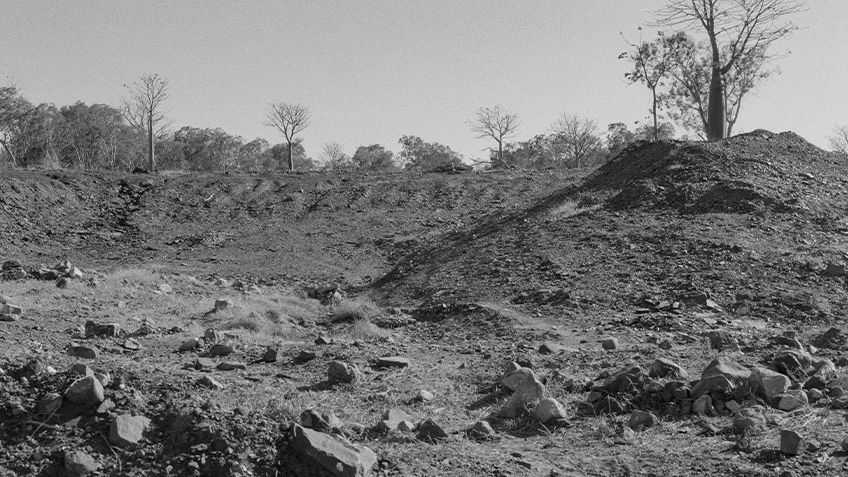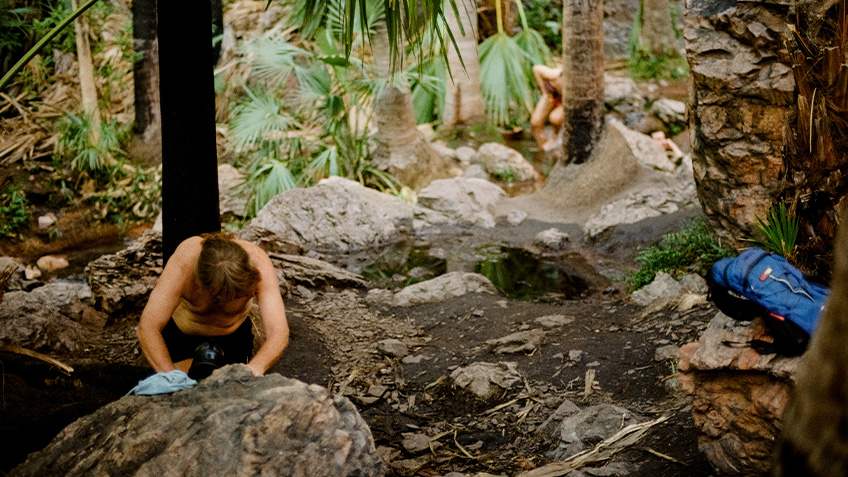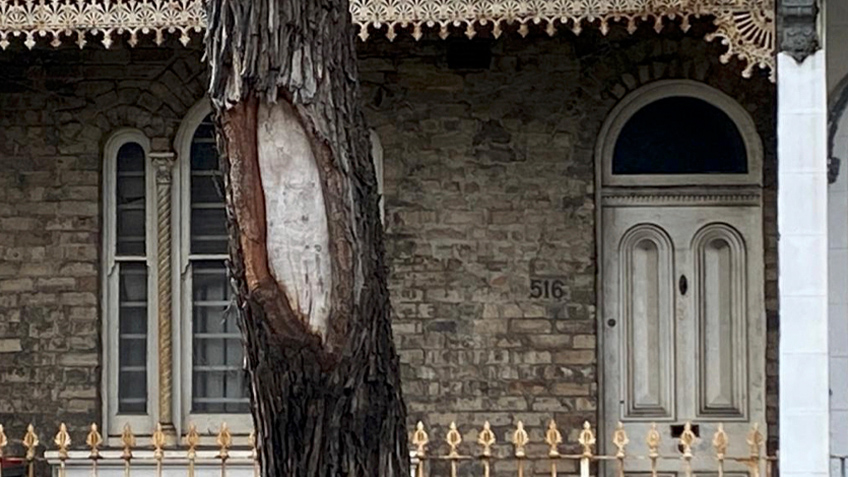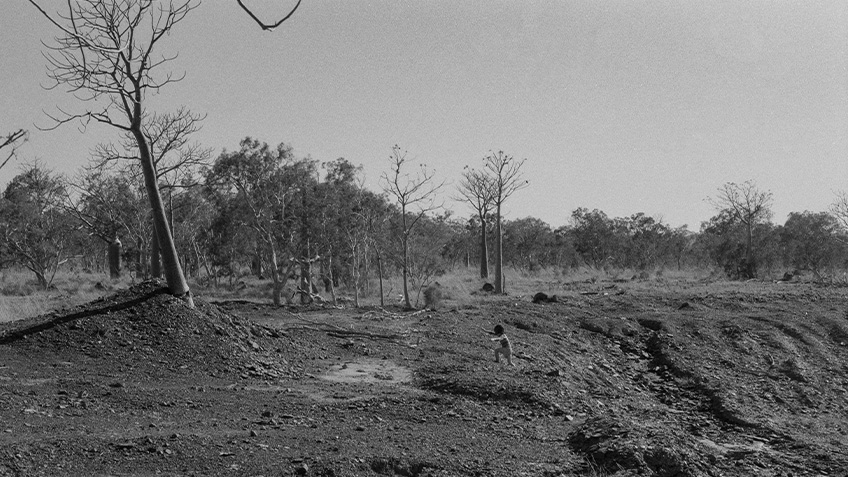As part of The National 2021: New Australian Art exhibiting artist Alana Hunt will be Carriageworks inaugural Writer in Residence. Working progressively over the course of the exhibition she will publish Conversations and Correspondence—six texts that take as their starting point the bodies of work All the violence within this and In the national interest both exhibited as part of the exhibition.
For the second in the series, Relations, Alana Hunt is in correspondence with the artists Narelle Jubelin and Diana Wood Conroy—both senior artists with practices that have been active since the 1980s and 1970s respectively.
Alana Hunt: I want to begin by going back a little. In February 2019 I sent a newsletter—another form of correspondence within my practice—in which I shared an image that was prompting me to make new work. I had written:
This image, from the Uffe B. Hansen collection, which I found scrolling through the Kununurra Historical Society’s Flickr account while making work for Temporary Certainty last year, has rarely left my mind. It has me stewing over the relationship between leisure and colonisation. All the violence leads to this.
Narelle, you wrote back to me almost immediately.
Looking at this image now, it still makes my stomach turn. Apparently it was taken in 1961, the same year the town of Kununurra was established—built from agricultural dreams of development that rendered places like this, what had been a home to Miriwoong people, suddenly a picnic destination for the colonists.
These people sit here with their children less than 40 years after the nearby Oombulgurri /Forrest River massacre of 1926. The last of many that had preceded it. They sit here in 1961 eating watermelon while neck chains were openly used on Aboriginal people in this region until 1958.
But what this image depicts has only continued in the present, and it is this I’ve tried to capture in the work All the violence within this.
I am curious. What was it in my newsletter from February 2019 that made you, an Australian in Madrid, reply?
Narelle Jubelin: I think it struck a chord with me as I have often dipped into 35mm slides that my parents took thinking of their intimate imagery as an archive. I rendered some of them as petit points in Owner Builder of a Modern California House. Others were assembled in a powerpoint and saved as a video, where for Ilford Colour I intercut the images with quotes from Walter Benjamin tracking the formative thoughts and early development of his son Stefan’s speech, who was later sent into exile to Australia. My parents’ photographs are from the mid ‘60s where I grew up in an inner north-west Sydney owner-built bungalow. Many of the images reflect the clearing and domestication of the bush block, set back on a dead end street on Dharug / Darug land and waters.
In the image you refer to, the punctum could be the girl child sitting with her legs splayed, compositionally she is just off center, her whiteness drawing our eyes—but it returned me to a memory of my family burning a huge termite mound up above the house, whilst it was under construction. The triangular block of land tapered to a rock outcrop.
This new suburb was bordered by Ku-ring-gai Chase National Park so in a very real sense we lived your photograph.
AH: I hope in my work people are able to see that we’re all living parts of these photographs. But it is not something necessarily grasped with ease. In October 2019 I shared some of the first images from All the violence within this on social media. In the post I wrote about the arrogance and violence grounded in the assumption that we (non-Indigenous people) have a right to be here. And by ‘here’ I don’t mean this spring in particular, but more Australia as a whole. I also included these words from Evelyn Araluen’s Sydney Review of Books essay:
Do you know what lores I have had to learn while you play in everything they protect?… Do you understand that when you write the kangaroo the wallaby the bilby the bandicoot the cockatoo the blacksnake the waterlily the brush the bush the sapling the ghost gum that you are puppeting your hands through ancestors, through relations?
Someone who lived locally commented. They had been to this place many times, and said they’d be horrified to be categorised as violent or ignorant. They expressed concerns about my images, likening them to a form of surveillance, they said, was a violent act in itself. Never mind the whole town had recently been covered in numerous surveillance cameras—my walk to do the groceries or visit the post office with my son, now available for viewing on multiple screens in the heart of the local police station every hour of every day.
I think this kind of response, illustrates how uncomfortable we are, or perhaps how unable we are, to see ourselves. I think about this a lot; am I able to see my culture? To poorly paraphrase the Hindi writer Uday Prakash—the fish does not know the sea, the camel does not know the desert, the bee does not know honey—I think we’re kind of in a contradictory state that swings between deep knowing and blindness, like the fish and the camel and the bee.
But, unlike this person who commented, I don’t see violence as something distant from myself. I know I’m implicated in it, like a sticky goo encompassing my body, I try to pull away from it but ultimately can’t. That’s the nature of settler-colonisation; we’re implicated indefinitely. I am also aware of how colonisation and nation-state’s craft violence. Within this gamut is the violence of representation, the historical continuum of non-Indigenous people representing Aboriginal people, and the power that plays into and forges. So here, in these pictures I am simply shifting the lens a little towards the colonists. And in doing so, it is interesting how quickly that discomfort, or sense of indignation, emerges.
Ilford Colour draws on your own family’s archive; quite literally close to home. It’s a kind of geography and architecture that is familiar to me too. But we never owned a house like this—my mother often cleaned them, and I’d walk the grounds. Or we’d be renting and move in and out of them all too frequently. So when I see your video, I look at it with a certain sense of longing that I remember from childhood—to belong, to own, to be home, to not move. But at the same time I also feel angry at the casual, familial nature of colonisation wrapped up in that deceptively simple dream to have a home (albeit at the cost of someone else’s). Your use of colour, and its inversion, conveys some of that violence to me, and the accumulation of time passing, of the landscape changing, of people ageing, of colonisation solidifying. And of Walter Benjamin’s son Stefan, and his part in this “Australian” story too.
NJ: I have been looking over the photographs in All the violence within this and want to take us to inner city Sydney. A few months back I received correspondence from an artist and friend named Jacky Redgate; that state that swings between deep knowing and blindness has been at the center of our conversations for decades. Jack sent a whatsapp:
Dear Narelle I was just talking to Diana [Wood Conroy] and remembered a scarred shield / container tree you pointed out to me once years ago on ___________ Street near ________. I went looking for it to show Diana and I think this is it… it would have grown. Diana said it’s a stringy bark… and extraordinary.
Jacky later wrote and sent more photographs:
I wrote to the council but they said it was a scar from a car hitting it… maybe better less people know so it doesn’t get vandalised too.
Diana Wood Conroy: That wounded tree in the busy city street that Jacky photographed is like a flag reminding you of another way of looking. In the southern highlands there are still scar trees, but they are not revealed, they stand beside the road with the oblongs of a shield almost invisible under another layer of burning. This is because of the justifiable fear by elders of vandalism from locals who are still hostile to any thought of Aboriginal ownership, even of a tree. One of those aunties, with persistent kindness, still volunteers to teach culture at the primary school where my grandson learns from her.
It’s moving to read these thoughts on the place non-Indigenous people find themselves in because of the hidden history of colonial violence and take-over. That picture taken in 1961 could have been my family picnicking in Kuringai Chase 10 years earlier, happy and ignorant, often near Aboriginal carvings which even then had a huge aura. Narelle would know these places too.
But nobody knew that the Dharug people were still living in crevices of the vast Kuringai bush until the 1950s. Aboriginal people were not mentioned at school. We learnt about “the discovery” of Australia by explorers, with black maps of the continent that gradually had seams of yellow light going through them following the trails of the “explorers”, journeying through Country already deeply known.
You are right Alana about the deep discomfort of being non-Indigenous in ancient places and the constant sense of being blind to unconscious bias. “Nothing can be known except according to the mode of the knower” as the theologian Philip Sherrard observed years ago. Documenting those raped landscapes is painful. And the context for your installation at Carriageworks of the palm springs is their take-over by unknowing tourists.
Yolngu elder and old friend Banduk Marika and I lived together for a time in North Sydney. She didn’t want probing or curiosity about her culture and actually told me to learn about my own fundamental roots: go back to your own culture.
AH: The image of that tree at South Darling speaks to a world. As does the Council’s response. Last year the public was generally shocked by what happened at Juukan Gorge. But what took place is not an aberration. This is the story of our country, as it has unfolded in this way on a daily basis for over two centuries, and for most part, within the apparent rule of law. It is easy to look back at the past—to acknowledge the wrongs of others, as though we no longer perpetrate similar things. But there is a continuum with the past rather than any sense of rupture or break. The council’s response is evidence of this. And we all play a part.
But Diana, I am curious, where did Banduk Marika’s advice lead you?
DWC: Alana I still mourn the Juukan Gorge, it was outrageous ignorance and arrogance and there must be retribution for the unfathomable destruction of irreplaceable heritage. But as you say, how to monitor the vast interior spaces when the actions are “lawful”, is the same problem as always.
Banduk turned me back towards the basis of European language, law and materiality. (The Greeks invented colonialism and the Romans developed it.) Soon after I spoke to her, I got an invitation to be artist-in-residence and manager of an archaeological excavation of a Hellenistic-Roman theatre in Paphos Cyprus by one of my former lecturers in Archaeology at the University of Sydney, who was invited by the Cypriot Director of Antiquities to excavate the theatre. Nothing is taken out of Cyprus, and the Australians are required to publish everything in order to retain a licence to dig. We work closely with the Cypriots. That was in 1996, and I was last there in the monthly season of 2019. My son Rowan who used to go with me, became a photographer, skills learnt on the site, and now explores contemporary detritus in Australia. My old friend, distinguished Tiwi artist Bede Tungutalum, is very keen to be an artist on the Paphos site. The ancient Mediterranean is much less ancient than the Juukaan Gorge but does reveal different ways of being, often more congruent with oral cultures that harbour invisible spirits, than with modernity. It’s complicated! How is it in the Kimberley? What do the people think about the Juukan Gorge?
NJ: And of the gag order Rio Tinto are still attempting to implement over the Puutu Kunti Kurrama and Pinikura custodians? At my geographic/time lagged distance I always feel about to cut or disrupt our conversation wanting, like Diana, to know how you are feeling there and then wake with an inevitable delay to read alerts of damage—again—this time, to the sacred Kooyang / Kuyang Stone Arrangement site at Lake Bolac at the same time as I received your Cups of nun chai book from Delhi this morning Alana, gracias—sickened, deeply saddened and can only think of reaching out to friends there on the ground in Victoria to see if they are supported and ok—
AH: I can tell you what I think about Juukan Gorge. And unfortunately I wasn’t shocked by it, or by news of the recent damage in Victoria you mention. This is a persistent state of affairs where I live—and in Australia more broadly. It is not just about mines and farmers doing the occasional damage, this is the story of every house, every road, every dam. This is our story, but somehow we tend to think it is unusual, shocking.
At the opening of her recent book Living on Stolen Land Ambelin Kwaymullina writes:
You are on Indigneous land
swimming in Indigenous waters
looking up at Indigenous skies
There is no part of this place
that was not
is not
cared for
loved
by an Aboriginal or Torres Strait Islander nation
there are no trees
rivers
hills
stars
that were not
are not
someone’s kin
Our legal system is so ill-equipped, no, I think it is more accurate to say our legal system is very well equipped to enable the destruction of Country. In WA if you want to damage or destroy an “Aboriginal site” you simply fill in a rather brief pdf. Since the Aboriginal Heritage Act was implemented in WA in 1972 the overwhelming majority of these applications, somewhere over 90%, have been approved—legally permitting this destruction and damage, because you know, it is “in the national interest”. It would be far more accurate to term the Act, the Destruction of Aboriginal Heritage Act, because it has literally enabled the legal destruction of far more than it has ever protected. The fact that the destruction that took place at Juukan Gorge was legal helped to make parts of the hypocrisy of this system more visible. But there are thousands of similar instances we never hear about, every single day. And even when things are clearly illegal the path towards prosecution is almost impenetrable. The WA Government recently decided not to prosecute Kimberley Granite for damaging important sites that the late R. Peters and his sister Mabel Juli, both acclaimed artists, were culturally responsible for.
I think the fact our legal and political system, and by extension our culture, tries to compartmentalise ‘Aboriginal sites’ runs against everything Kwaymullina says so clearly above. It suits us to say an Aboriginal site is here, but not here. To really acknowledge that every inch of this country is Aboriginal land, owned and treasured and full of story, history and memory, is too confronting for our culture to reckon with because it points to the illegitimacy of our own life here. Instead we claim blindness, and then try to draw lines and borders around certain places, in order to make our presence outside of these places palatable. As someone who has worked in archaeology Diana, how do you negotiate the compartmentalising of Aboriginal sites, which are no doubt important, but then implicitly render other places less important. Is it possible to navigate that inherent hierarchy in a way that respects what Kwaymullina has said?
DWC: Alana, you write that to acknowledge Aboriginality in every part of the land is impossible for non-Indigenous culture to reckon with, because it points to the illegitimacy of our presence here. And that we draw lines and borders around places and make laws to justify that. Yes, that is what we do.
Thirty years ago I made drawings about the imposition of the grid on the Tharawal and Wodi Wodi middens and relics in the sand dunes of the South Coast around Wollongong, because that is the way our culture since the eighteenth century functions. Order is created, we think, by proportion and making maps and boundaries imposed on land, not only in Australia but wherever the colonial powers rested. We layer the grid of text on oral cultures, the building of surveyed hard roads over dirt tracks, the construction of heavy monumental built environments where none were. We saw the land as hostile and to be conquered, and destroyed fragile ecosystems in the process. We put up fences, making ceremonial sites inaccessible. We put people from open spaces in terrible prisons, for crimes that are often incomprehensible to them, still.
No one can deny this. Compartmentalisation is the way we are, a basic requirement in our education system, in every institution. We sift, we categorise. We think in abstract concepts.
In the Tiwi Islands everyone can be an artist and would be required to do so for ceremonies, unlike our artists who have to be part of a hierarchy to survive. This is why I have been so moved by the people I have known in North-East Arnhem Land and the Tiwi Islands, still with land and language, (although the mining at Nhulunbuy has been devastating, hence the Bark Petition) and their generosity in wanting to educate balanda, white people, and work with them in Both Ways methods, to get the best from both systems. Otherwise where are we?
My colleague Professor Lesley Head, now Head of the Academy of Humanities in Australia, said on RN this week how much improved archaeology had been after decades of interaction—there is slow growth in working together (she dug at Jinmium with local custodians there in 1996, on the border of WA and NT). Tiny events perhaps, but pointers.
I’ve spent nearly 10 years, with some interruptions, trying to document all the forgotten old artists, and the patterns instigated by young artists, that I worked with in the Tiwi Islands in 1974. I wanted to recount how modernisation happened, how art centres became important. It’s from a personal perspective, interspersed with research. In order not to despair at the situation of Aboriginal and Torres Strait Islander people I have taken a personal position that to be close to one Aboriginal person and relations at least, to support them through thick and thin, unobtrusively, is something.
We began with your discovered image of a white family absolutely unaware of what the rocky cave they sat in was about, ignorant that close by there was a massacre site. I love your powerful passion for bringing the colonial devastation to mind. This is very necessary. My viewpoint is that I want to mitigate the hopelessness of assuming complete incommensurability between Indigenous and non-Indigenous ways of being on land (which is of course what the early rural settlers believed). Tentatively, I’d like to connect as individuals within the mosaic of Australia as it is now, to redress and heal.
NJ: And to seek justice.
AH: I agree with you, in the sense that relationships are vital, all we really have to hold in this difficult world we now unavoidably share.
And I hope it is not completely incommensurable—but I am full of doubt. We certainly aren’t seeing ourselves, our own role in the ongoing process of colonisation, to the degree we need to. That is what I am trying to do with a lot of my art at the moment, and even through this correspondence—to forge something like an ethnographic, or anthropological, examination of non-Indigenous Australia, of our own colonial culture, of ourselves. To shift things, so we can start to think about the colonial problem instead of despairing about “Indigenous issues”.
But it is interesting, how entwined this is with Indigenous Australia. Even in this conversation we all keep reverting to encounters with Indigenous people or places or things. Aboriginal people are able to understand themselves outside of the construction of “Australia” as a nation, they have an outside of colonisation to reach to. We don’t really.
NJ: Some years ago on the outskirts of Melbourne a Yolngu man named Gali Yalkarriwuy Gurruwiwi was recorded as he danced with family, to celebrate his granddaughter’s year ten graduation. They danced on a platform with cut eucalyptus branches rimming the border and what I remember was that it was filmed from below with ‘us’ the tv news audience looking up. I subsequently read that in 2015, when it had been filmed and aired, that snippet of video was the most popular video screened on the ABC that year.
Just searched and re-found it—it is still there—a suburban if not federation style house partially visible behind them—
As a kind of footnote to considering archeology and to your provocation for a critical ethnography of non-Indigeneity—just over 25 years ago I was invited to participate as a consulting curator in the development of a museum on the site of another ‘house’ in Sydney. The Museum of Sydney on the site of the First Government House, was by necessity a highly contentious ground, itself a disputed and sensitive archaeological dig, before redevelopment, and deemed to be representative of the first 60 years of colonial occupation. The foundational team was intercultural, interdisciplinary and intergenerational and soon after the inauguration MoS received critique from some Indigenous community members that they preferred their material culture not be interwoven with the resurfaced archeological rubble of the occupiers. We had significant Eora Nation material on loan from various museums and I understand that the response from the museum staff, that stayed on after the opening, was swift, agile and respectful. The Aboriginal cultural material was collectively consolidated to a self contained floor of the building adjacent to an important, redemptive video work Eora that had earlier been commissioned to Wiradjuri/Kamilaroi photographer and filmmaker Michael Riley (1960-2004). The reconsideration and relocation of Indigenous cultural material, for its time, was a deft museological move.
Alana, far above Diana mentioned, not in passing, that documenting those raped landscapes is painful and thinking of the child navigating the stark, deliberately black & white shots of your series In the national interest. Do you want to talk about their presence a bit please?
AH: You know, the child is my son. I didn’t initially intend for him to be part of the images. But he is usually with me when I photograph and I occasionally take a few pictures of him for personal use. When the film was processed, his presence in these images spoke directly to the work itself. I think there is a playfulness but also a horror in his presence here, and this bounces off the horrible sense of playfulness of the figures depicted in All the violence within this.
These black and white images that he is a part of are small scale mines, often for gravel, that dot the highways where I live—appearing persistently in the landscape, like cigarette burns piercing a tortured body. In the national interest is a picture of the world our lives are producing, and it is this world that my son will be forced to navigate.



